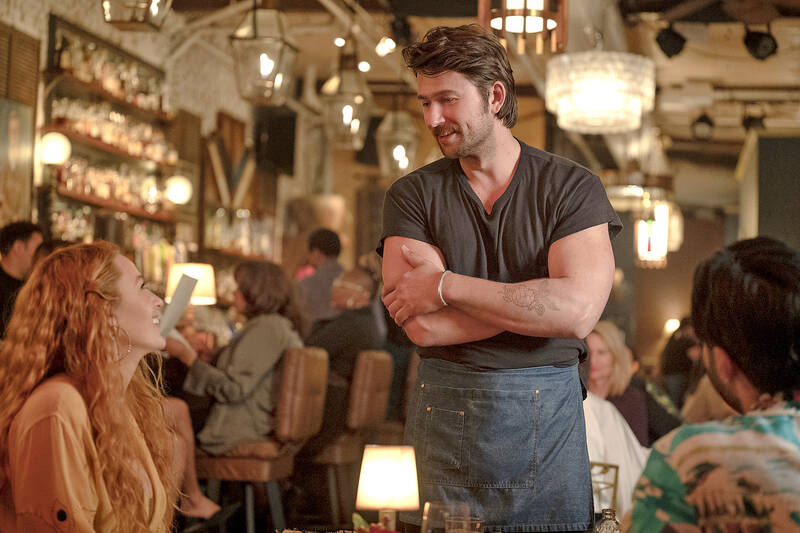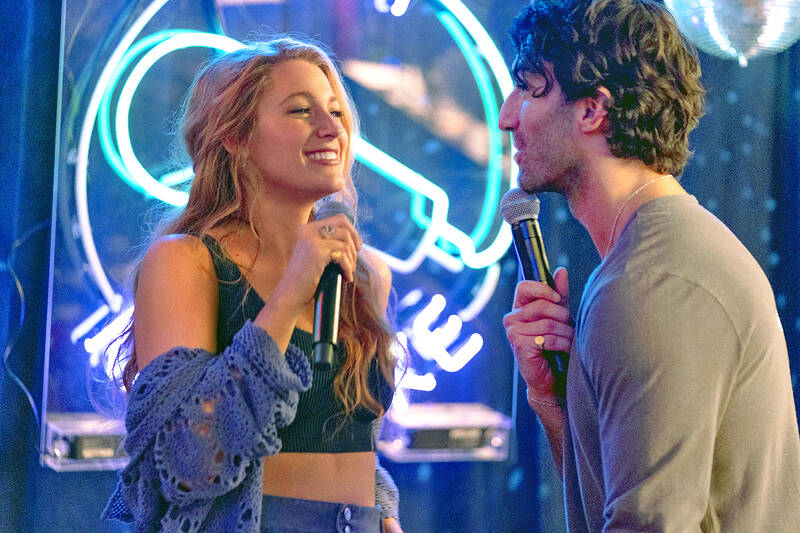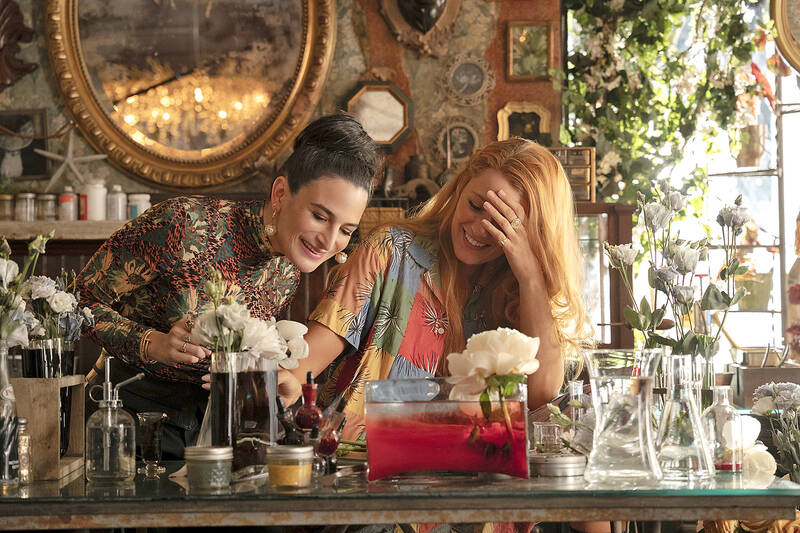Lily Bloom and Ryle Kincaid don’t really meet-cute. On a rooftop in Boston, he announces himself by angrily kicking a patio chair. She’s up there trying to come to terms with her abusive father’s death. They talk about maraschino cherries, gun violence and flirt. There’s something off about this pair. But there’s also an obvious attraction.
So begins the uneven movie adaptation of Colleen Hoover’s best-selling 2016 novel It Ends With Us starring Blake Lively, which tries to balance the realities of domestic violence inside a rom-com and a female-empowerment movie. All suffer in the process.
It veers too close to melodrama, with suicide, homelessness, generational trauma, child murder, unintended pregnancy and never-forgotten love all touched on and only half digested. Set in Boston, it never even pulls from that city’s flavor.

Photo: AP
The film centers on Lively’s Lily, a flower shop owner who finds herself in the middle of a complicated love triangle between hunky neurosurgeon Ryle — Justin Baldoni, who also directs — and her hunky high school sweetheart, Atlas, played with hangdog cuteness by Brandon Sklenar.
There are red flags about Ryle but they aren’t obvious until they’re strung together, which takes, literally, years. Credit to the filmmakers for not making the potential abuser so easy to wave a red flag about.
The most powerful thing about It Ends With Us is the after-effects of domestic violence and how they unmoor those who witness or survive it. This could have been tightened or highlighted more. (The end credits direct viewers to the anti-domestic violence group No More.)

Photo: AP
Baldoni perfectly balances menace and seduction, operating in the zone between assertive and psychotic. And his direction is good, with an ability to summarize scenes quickly and move the plot elegantly, although he does have a fondness for too many music-led montages.
Lively is fine here, veering dangerously close to Manic Pixie Dream Girl with her cute flower sketches and love of shabby chic, but perks up at the end. She wears a lot of rings and a lot of florals but can also stun a room in a cut-out dress.
The script by Christy Hall has some terrible clunkers — “This man runs through women like candy,” someone says at one point — but nicely maneuvers around the book’s weird spots, like making Lily’s dad’s funeral a flashback instead of an odd recreation on the rooftop.

Photo: AP
But It Ends With Us doesn’t end quickly enough — more than two hours drag — with tangents and poor editing, like sudden scene cuts that leave viewers looking for clues to where they are.
And we have so many questions, like how Lively’s character got onto the roof of that luxury highrise in the first place. And what’s with Lily’s best friend — Jenny Slate, clearly stealing the movie — who wears Valentino dresses and carries a purse that costs the same as a small car? She clearly doesn’t need a retail job, but works at the flower shop anyway?
And what’s with the weird relationship with Carhartt — check out the copycat logo appearing and disappearing from jackets and jumpsuits — apparently trying to show the wearers as down-to-earth working class folks, when they are not.
The movie’s adoration of wealth and luxury — from a Mercedes to million-dollar apartments and fancy dinner reservations — I guess are attempts to show that domestic violence isn’t confined to sports bars and factories.
What’s very funny is that Lily clearly has a type: Both her paramours are dark-haired buff dudes who favor tight black T-shirts, have stubble beards and adore her. When they fight — and they do — it’s actually hard to tell them apart.
The bursting soundtrack — with Thom Yorke’s Dawn Chorus, Lewis Capaldi’s Love the Hell Out of You and Brittany Howard’s I Don’t represented — has the undeniable presence of Lively bestie Taylor Swift, who has lent her My Tears Ricochet.
When Lily and Ryle finally hook up for the first time, she warns him: “Don’t let me regret this.” She will, of course. And a few others who are part of this film probably will, too.

One of the biggest sore spots in Taiwan’s historical friendship with the US came in 1979 when US president Jimmy Carter broke off formal diplomatic relations with Taiwan’s Republic of China (ROC) government so that the US could establish relations with the People’s Republic of China (PRC). Taiwan’s derecognition came purely at China’s insistence, and the US took the deal. Retired American diplomat John Tkacik, who for almost decade surrounding that schism, from 1974 to 1982, worked in embassies in Taipei and Beijing and at the Taiwan Desk in Washington DC, recently argued in the Taipei Times that “President Carter’s derecognition

This year will go down in the history books. Taiwan faces enormous turmoil and uncertainty in the coming months. Which political parties are in a good position to handle big changes? All of the main parties are beset with challenges. Taking stock, this column examined the Taiwan People’s Party (TPP) (“Huang Kuo-chang’s choking the life out of the TPP,” May 28, page 12), the Democratic Progressive Party (DPP) (“Challenges amid choppy waters for the DPP,” June 14, page 12) and the Chinese Nationalist Party (KMT) (“KMT struggles to seize opportunities as ‘interesting times’ loom,” June 20, page 11). Times like these can

JUNE 30 to JULY 6 After being routed by the Japanese in the bloody battle of Baguashan (八卦山), Hsu Hsiang (徐驤) and a handful of surviving Hakka fighters sped toward Tainan. There, he would meet with Liu Yung-fu (劉永福), leader of the Black Flag Army who had assumed control of the resisting Republic of Formosa after its president and vice-president fled to China. Hsu, who had been fighting non-stop for over two months from Taoyuan to Changhua, was reportedly injured and exhausted. As the story goes, Liu advised that Hsu take shelter in China to recover and regroup, but Hsu steadfastly

You can tell a lot about a generation from the contents of their cool box: nowadays the barbecue ice bucket is likely to be filled with hard seltzers, non-alcoholic beers and fluorescent BuzzBallz — a particular favorite among Gen Z. Two decades ago, it was WKD, Bacardi Breezers and the odd Smirnoff Ice bobbing in a puddle of melted ice. And while nostalgia may have brought back some alcopops, the new wave of ready-to-drink (RTD) options look and taste noticeably different. It is not just the drinks that have changed, but drinking habits too, driven in part by more health-conscious consumers and